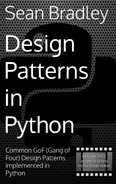Raycaster Collision Detection
Video Lecture
Your browser does not support the video tag.
Description
While raycasting is almost always used for mouse picking objects in the 3D scene, it can also be used for simple collision detection.
In this example, I detect whether the orbit controls will penetrate another object and adjust the cameras position so that it stays outside.
Essentially, I am creating a ray from the camera target to the camera position. If there is an intersected object between, then the camera position is adjusted to the intersect point. This prevents the camera from going behind a wall, or inside a box, or floor, or any object which is part of the objects array being tested for an intersection.
Also, instead of using the raycaster to find the new point to position the camera in case of collision between the target and itself, I could instead modify the opacity of the object in between and not move the camera. Rotate the camera and notice how any object between the camera target and the camera itself, becomes transparent.
Code
./src/client/client.ts
1
2
3
4
5
6
7
8
9
10
11
12
13
14
15
16
17
18
19
20
21
22
23
24
25
26
27
28
29
30
31
32
33
34
35
36
37
38
39
40
41
42
43
44
45
46
47
48
49
50
51
52
53
54
55
56
57
58
59
60
61
62
63
64
65
66
67
68
69
70
71
72
73
74
75
76
77
78
79
80
81
82
83
84
85
86
87
88
89
90
91
92
93
94
95
96
97
98
99
100
101
102
103
104
105
106
107
108
109
110
111
112
113
114
115
116
117
118
119
120
121
122
123
124
125
126
127
128
129
130
131
132
133
134
135 import * as THREE from 'three'
import { OrbitControls } from 'three/examples/jsm/controls/OrbitControls'
import Stats from 'three/examples/jsm/libs/stats.module'
const scene = new THREE . Scene ()
const camera = new THREE . PerspectiveCamera (
75 ,
window . innerWidth / window . innerHeight ,
0.1 ,
1000
)
camera . position . z = 2
const renderer = new THREE . WebGLRenderer ()
renderer . setSize ( window . innerWidth , window . innerHeight )
document . body . appendChild ( renderer . domElement )
const raycaster = new THREE . Raycaster ()
const sceneMeshes : THREE.Mesh [] = []
const dir = new THREE . Vector3 ()
let intersects : THREE.Intersection [] = []
const controls = new OrbitControls ( camera , renderer . domElement )
controls . enableDamping = true
controls . addEventListener ( 'change' , function () {
xLine . position . copy ( controls . target )
yLine . position . copy ( controls . target )
zLine . position . copy ( controls . target )
raycaster . set (
controls . target ,
dir . subVectors ( camera . position , controls . target ). normalize ()
)
intersects = raycaster . intersectObjects ( sceneMeshes , false )
if ( intersects . length > 0 ) {
if (
intersects [ 0 ]. distance < controls . target . distanceTo ( camera . position )
) {
camera . position . copy ( intersects [ 0 ]. point )
}
}
})
const floor = new THREE . Mesh (
new THREE . PlaneGeometry ( 10 , 10 ),
new THREE . MeshNormalMaterial ({ side : THREE.DoubleSide })
)
floor . rotateX ( - Math . PI / 2 )
floor . position . y = - 1
scene . add ( floor )
sceneMeshes . push ( floor )
const wall1 = new THREE . Mesh (
new THREE . PlaneGeometry ( 2 , 2 ),
new THREE . MeshNormalMaterial ({ side : THREE.DoubleSide })
)
wall1 . position . x = 4
wall1 . rotateY ( - Math . PI / 2 )
scene . add ( wall1 )
sceneMeshes . push ( wall1 )
const wall2 = new THREE . Mesh (
new THREE . PlaneGeometry ( 2 , 2 ),
new THREE . MeshNormalMaterial ({ side : THREE.DoubleSide })
)
wall2 . position . z = - 3
scene . add ( wall2 )
sceneMeshes . push ( wall2 )
const cube : THREE.Mesh = new THREE . Mesh (
new THREE . BoxGeometry (),
new THREE . MeshNormalMaterial ()
)
cube . position . set ( - 3 , 0 , 0 )
scene . add ( cube )
sceneMeshes . push ( cube )
const ceiling = new THREE . Mesh (
new THREE . PlaneGeometry ( 10 , 10 ),
new THREE . MeshNormalMaterial ({ side : THREE.DoubleSide })
)
ceiling . rotateX ( Math . PI / 2 )
ceiling . position . y = 3
scene . add ( ceiling )
sceneMeshes . push ( ceiling )
//crosshair
const lineMaterial = new THREE . LineBasicMaterial ({
color : 0x0000ff ,
})
const points : THREE.Vector3 [] = []
points [ 0 ] = new THREE . Vector3 ( - 0.1 , 0 , 0 )
points [ 1 ] = new THREE . Vector3 ( 0.1 , 0 , 0 )
let lineGeometry = new THREE . BufferGeometry (). setFromPoints ( points )
const xLine = new THREE . Line ( lineGeometry , lineMaterial )
scene . add ( xLine )
points [ 0 ] = new THREE . Vector3 ( 0 , - 0.1 , 0 )
points [ 1 ] = new THREE . Vector3 ( 0 , 0.1 , 0 )
lineGeometry = new THREE . BufferGeometry (). setFromPoints ( points )
const yLine = new THREE . Line ( lineGeometry , lineMaterial )
scene . add ( yLine )
points [ 0 ] = new THREE . Vector3 ( 0 , 0 , - 0.1 )
points [ 1 ] = new THREE . Vector3 ( 0 , 0 , 0.1 )
lineGeometry = new THREE . BufferGeometry (). setFromPoints ( points )
const zLine = new THREE . Line ( lineGeometry , lineMaterial )
scene . add ( zLine )
window . addEventListener ( 'resize' , onWindowResize , false )
function onWindowResize () {
camera . aspect = window . innerWidth / window . innerHeight
camera . updateProjectionMatrix ()
renderer . setSize ( window . innerWidth , window . innerHeight )
render ()
}
const stats = new Stats ()
document . body . appendChild ( stats . dom )
function animate () {
requestAnimationFrame ( animate )
controls . update ()
render ()
stats . update ()
}
function render () {
renderer . render ( scene , camera )
}
animate ()
Useful Links
Raycaster (Official Documentation)































